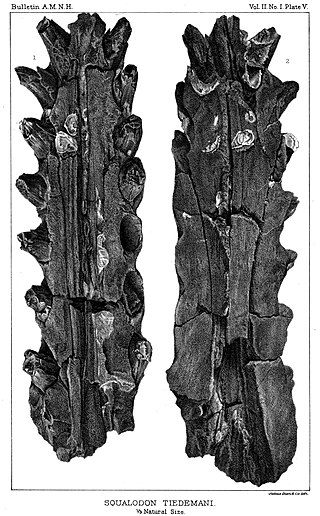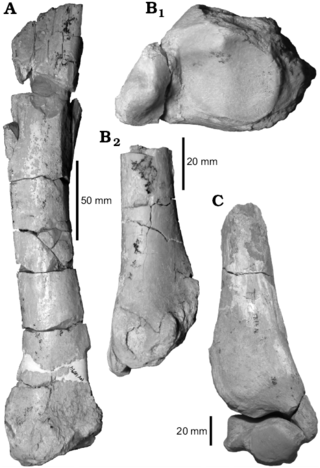Description
This animal, like all leontiniids, had a fairly robust body and strong legs. Unlike most of its relatives, however, Elmerriggsia was less than 1,5 meters long. Elmerriggsia had the V-shaped skull when viewed from above, the canine-shaped upper incisors (as well as the third lower incisor), and the mesodont typed dentition characteristic of all leontiniids.
The skull of Elmerriggsia was characterized by the presence of premolars with a grooved protocone, without an intermediate lingual cingulum, and by a well developed labial cingulum on the lower molars. These dental features distinguished Elmerriggsia from any other leontiniids.
Classification
Elmerriggsia fieldia was first described in 2012, based on fossil remains found near Pico Truncado in the Santa Cruz Province of Argentina, in terrains dated from the Deseadan (Late Oligocene). The fossils had been discovered over 75 years earlier, during an expedition to Argentina organized in 1924 by the Field Museum and led by Elmer S. Riggs, and were informally known as Leontinia sp.. Various fossils attributed to this animal were not only discovered near Pico Truncado, but also in various other areas of Argentina.
Elmerriggsia was a rather basal leontiniid, despite its Late Oligocene age ; according to a cladistic analysis carried out in 2012, Elmerriggsia was part of a basal clade of leontiniids, shared with the Eocene genera Martinmiguelia and Coquenia .

Paraceratherium is an extinct genus of hornless rhinocerotoids belonging to the family Paraceratheriidae. It is one of the largest terrestrial mammals that has ever existed and lived from the early to late Oligocene epoch. The first fossils were discovered in what is now Pakistan, and remains have been found across Eurasia between China and the Balkans. Paraceratherium means "near the hornless beast", in reference to Aceratherium, the genus in which the type species P. bugtiense was originally placed.

Huilatherium is an extinct genus of leontiniid, a group of hoofed mammals belonging to the order Notoungulata, that comprises other South American ungulate families that evolved in parallel with some mammals of the Northern hemisphere. The leontiinids were a family of herbivorous species comprising medium to large browsers, with relatively short skulls and robust limbs, somewhat similar to their relatives, the best known toxodontids.

Ankylorhiza is an extinct genus of toothed whale that lived in what is now the United States during the Oligocene epoch, between 29 and 23.5 million years ago. The type and only known species is A. tiedemani, though two fossil skeletons may represent an additional, second species within the genus. Ankylorhiza was about 4.8 meters (16 ft) long, with a long, robust skull bearing conical teeth that were angled forwards at the tip of the snout.
Ernestokokenia is an extinct genus of mammal, belonging to the Didolodontidae. It lived during the Early Eocene and the Middle Eocene, and its fossils were discovered in South America.
Ethegotherium is an extinct genus of Notoungulates, belonging to the suborder Typotheria. It lived from the Lower to the Middle Miocene, and its fossilized remains were discovered in South America. It might be a synonym of the genus Prohegetotherium.

Gualta is an extinct genus of leontiniid notoungulates. It lived during the Late Oligocene of what is now Argentina.

Periphragnis is an extinct genus of isotemnid notoungulates that lived from the Middle Eocene to the Early Oligocene in what is now Argentina and Chile.

Eomorphippus is an extinct genus of notohippid notoungulate that lived from the Late Eocene to the Early Oligocene in what is today South America.
Eurygenium is an extinct genus of notoungulate belonging to the family Notohippidae. It lived during the Late Oligocene in what is today South America.
Anayatherium is an extinct genus of notoungulate belonging to the family Leontiniidae. It lived during the Late Oligocene, and its fossilized remains were discovered in South America.
Colpodon is an extinct genus of herbivorous mammal, belonging to the order Notoungulata. It lived during the Early Miocene, in what is today Argentina and Chile, in South America.
Coquenia is an extinct genus of Notoungulate, belonging to the family Leontiniidae. It lived during the Middle Eocene, in what is today Argentina.
Martinmiguelia is an extinct genus of Notoungulate, belonging to the family Leontiniidae. It lived during the Middle Eocene, and its fossil remains were found in South America.
Termastherium is an extinct genus of leontiniid notoungulates that lived during the Early Oligocene of what is now Chile. Fossils of this genus have been found in the Oligocene-aged Abanico Formation of Chile.
Santiagorothia is an extinct genus of interatheriid notoungulate. It lived during the Early Oligocene, and its fossils were discovered in Argentina and Chile.

Cochilius is an extinct genus of interatheriid notoungulate that lived between the Late Oligocene and the lower Miocene in what is now Argentina.

Notopithecus is an extinct genus of Notoungulate, belonging to the suborder Typotheria. It lived from the Middle to the Late Eocene and its fossilized remains were discovered in South America.

Proborhyaena is an extinct genus of proborhyaenid sparassodont that lived during the Oligocene of what is now South America. It is considered to be the largest of the sparassodonts.
Rosendo is an extinct genus of notohippid notoungulates that lived during the Early Oligocene in what is now Argentina and Chile. Fossils of this genus have been found in the Sarmiento Formation and the Abanico Formations of Argentina and Chile.
Moqueguahippus is an extinct genus of notohippid notoungulates that lived during the Late Oligocene of what is now Peru. Fossils of this genus have been found in the Moquegua Formation of Peru, which it was named after.
This page is based on this
Wikipedia article Text is available under the
CC BY-SA 4.0 license; additional terms may apply.
Images, videos and audio are available under their respective licenses.

















